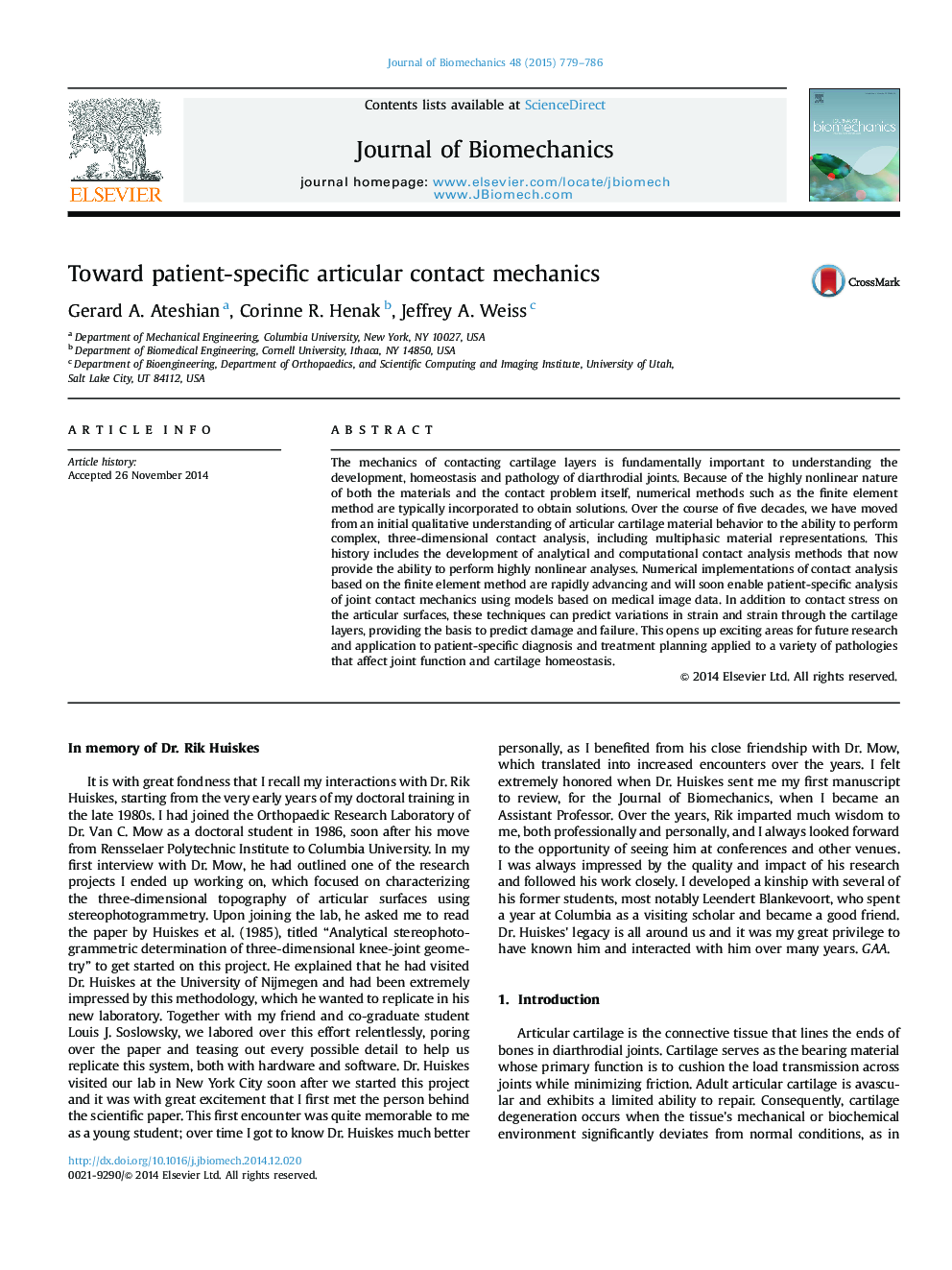| کد مقاله | کد نشریه | سال انتشار | مقاله انگلیسی | نسخه تمام متن |
|---|---|---|---|---|
| 10431587 | 910219 | 2015 | 8 صفحه PDF | دانلود رایگان |
عنوان انگلیسی مقاله ISI
Toward patient-specific articular contact mechanics
ترجمه فارسی عنوان
به سوی مکانیک تماس مفصل مفصلی بیمار
دانلود مقاله + سفارش ترجمه
دانلود مقاله ISI انگلیسی
رایگان برای ایرانیان
ترجمه چکیده
مکانیک تماس با لایه های غضروف بنیانی برای درک پیشرفت، هوموتازیست و آسیب شناسی مفاصل دیترودولی مهم است. به علت ماهیت بسیار غیر خطی مواد و مسائل مربوط به مخاطب، روش های عددی مانند روش المان محدود معمولا برای به دست آوردن راه حل ها در نظر گرفته می شوند. در طول پنج دهه، ما از یک درک کیفی اولیه از رفتار مواد غضروف مفصلی به توانایی انجام تجزیه و تحلیل تماس پیچیده، سه بعدی، از جمله مواد نمایشی چند فاز منتقل شده است. این تاریخ شامل توسعه روش های تحلیل تحلیلی و محاسباتی است که اکنون توانایی انجام تجزیه و تحلیل های بسیار غیر خطی را فراهم می کند. پیاده سازی عددی تجزیه و تحلیل تماس با استفاده از روش المان محدود به سرعت در حال پیشرفت است و به زودی تجزیه و تحلیل بیمار مکانیک تماس مشترک را با استفاده از مدل های مبتنی بر داده های تصویری پزشکی، را قادر می سازد. علاوه بر تماس با استرس بر روی سطوح مفصلی، این تکنیک ها می توانند تغییرات فشار و کرنش را از طریق لایه های غضروف پیش بینی کنند، و مبنایی برای پیش بینی آسیب و شکست ایجاد می کند. این زمینه های هیجان انگیزی را برای تحقیقات و برنامه های بعدی به تشخیص و برنامه ریزی درمان بیمار اختصاص داده و به انواع بیماری هایی که عملکرد مشترک و هوموستازی غضروف را تحت تاثیر قرار می دهد، باز می کند.
موضوعات مرتبط
مهندسی و علوم پایه
سایر رشته های مهندسی
مهندسی پزشکی
چکیده انگلیسی
The mechanics of contacting cartilage layers is fundamentally important to understanding the development, homeostasis and pathology of diarthrodial joints. Because of the highly nonlinear nature of both the materials and the contact problem itself, numerical methods such as the finite element method are typically incorporated to obtain solutions. Over the course of five decades, we have moved from an initial qualitative understanding of articular cartilage material behavior to the ability to perform complex, three-dimensional contact analysis, including multiphasic material representations. This history includes the development of analytical and computational contact analysis methods that now provide the ability to perform highly nonlinear analyses. Numerical implementations of contact analysis based on the finite element method are rapidly advancing and will soon enable patient-specific analysis of joint contact mechanics using models based on medical image data. In addition to contact stress on the articular surfaces, these techniques can predict variations in strain and strain through the cartilage layers, providing the basis to predict damage and failure. This opens up exciting areas for future research and application to patient-specific diagnosis and treatment planning applied to a variety of pathologies that affect joint function and cartilage homeostasis.
ناشر
Database: Elsevier - ScienceDirect (ساینس دایرکت)
Journal: Journal of Biomechanics - Volume 48, Issue 5, 18 March 2015, Pages 779-786
Journal: Journal of Biomechanics - Volume 48, Issue 5, 18 March 2015, Pages 779-786
نویسندگان
Gerard A. Ateshian, Corinne R. Henak, Jeffrey A. Weiss,
